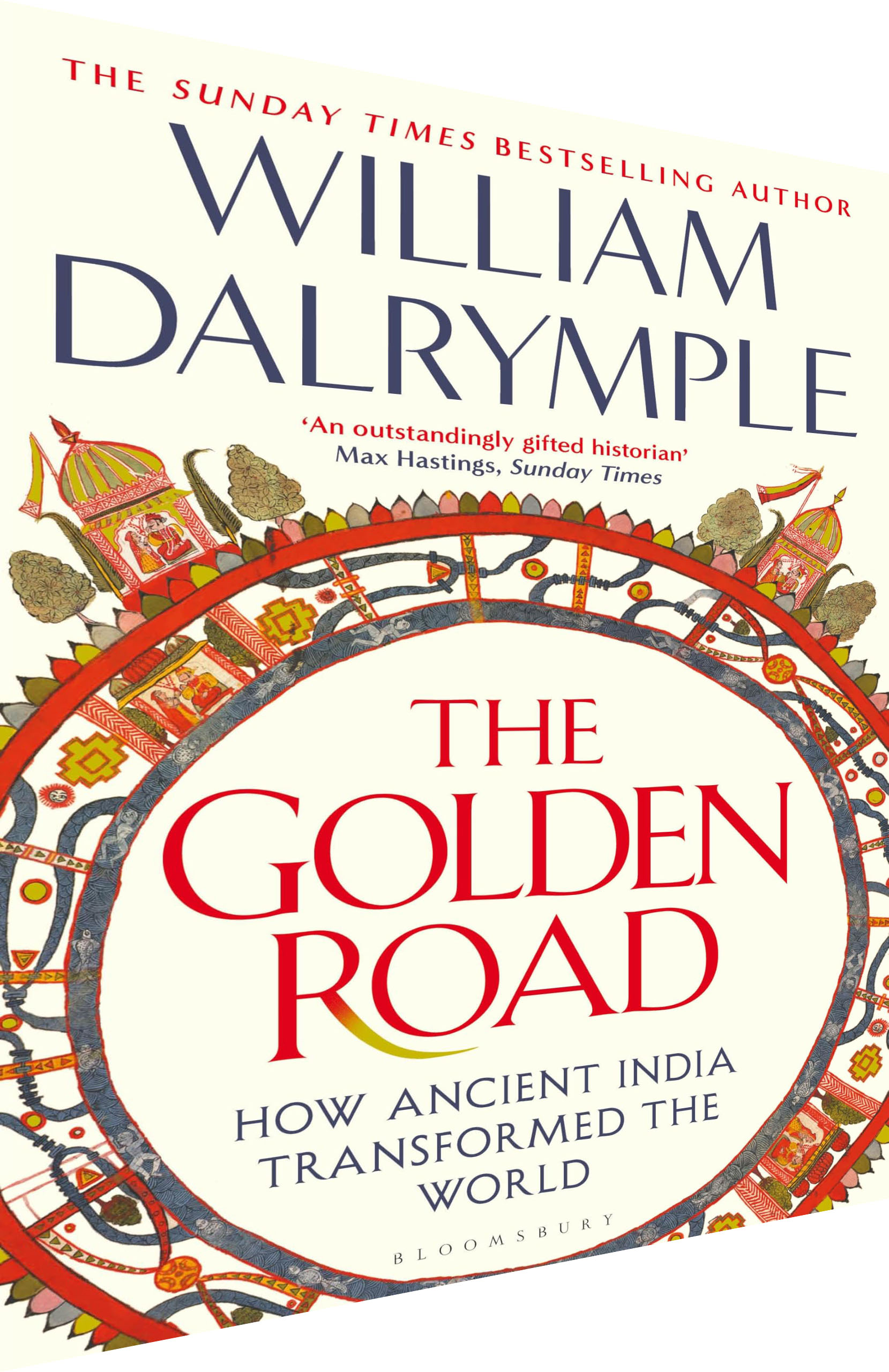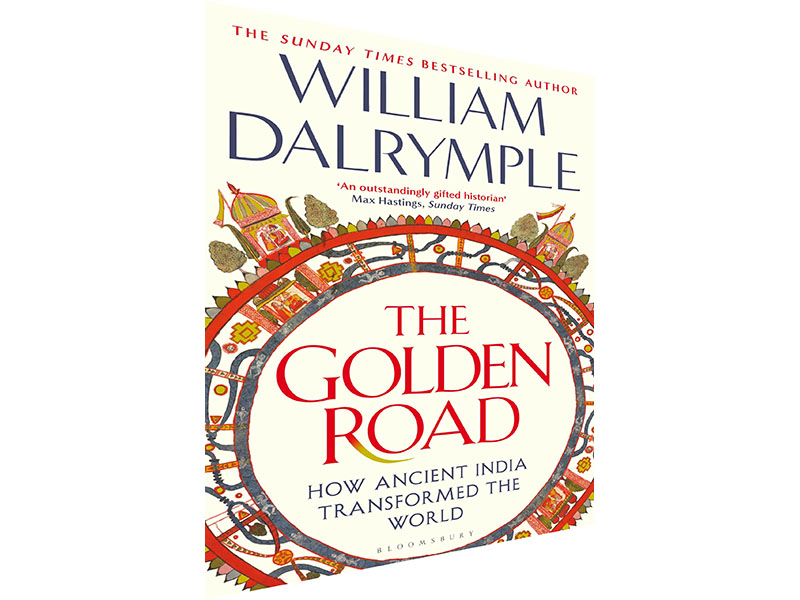
William Dalrymple
Bloomsbury
Rs.616 Pages 457
Dalrymple weaves an enthralling tale of how Indian trade, commerce, creeds, philosophies, science and mathematics spread east and west circa 1300 BCE
William Dalrymple is a master storyteller. This, he has proved time and again through his seven epochal books. For the many fans of history, he surpasses himself in this new book.
The Golden Road is a spell-binding compilation of facts, research and anecdotes that support his contention that contemporary India with none so poor to do it reverence these days, circa 1300 BCE was the world’s most advanced and influential landmass, rich in trade and commerce, culture and knowledge, sciences and technology which transformed the world. This assertion is supported by a huge bibliography of references, notations and archaeological data.
In this magnum opus, Dalrymple weaves an enthralling tale of how Indian trade and commerce, creeds, philosophies, advances in science, mathematics, astronomy, astrology spread through maritime routes from the Arabian Sea westwards to the shores of the Graeco-Roman empire, and from the Bay of Bengal, eastwards to South-East Asia, Suvarnabhumi, China and Japan. Across the Himalayas, over land and deserts, Indic influences traversed westwards through Central Asia to the borders of Russia.
Dalrymple challenges the theory, aggressively propounded by China and numerous historians, that it was the ‘Silk Route’ that was the main transnational highway which enabled Asian-Western trade and commerce. Dalrymple states that a millennium ago Indian sailors, merchants and adventurers who sailed westwards across the Arabian Sea and eastwards across the Bay of Bengal with their merchandise, monks, the philosophies of Buddhism, Jainism, Shaivism, Hinduism, their art and culture, and sciences to the Middle East, Central Asia, Afghanistan, Mongolia and China, Korea and Japan.
The Golden Road presents this sweeping history in ten chapters, each as engrossing as the next. In ‘A Gale of Stillness’, the author describes the accidental discovery of the Ajanta Caves in 1819 from which unfolds the story of the Buddha, Buddhism and the subsequent spread of Buddhism through emissaries of Emperor Ashoka beyond the boundaries of India through sea and land routes. Dalrymple writes that these 7th century murals indicate that India was not a self-contained peninsula, but already a cosmopolitan and urban society to which traders and pilgrims were drawn from around the world.
Archaeological discoveries stretching from Egypt (Berenike, Isis) to Gandhara, Burma, the Central Steppes, to South-East Asia reveal that Buddhist monasteries also served as major commercial centres of learning, trade and commerce and technology development. Flourishing trade brought great prosperity and was the life blood of the early Buddhist nations.
Dalrymple also uncovers a world of flourishing Indo-Roman trade and commerce ranging from precious diamonds and jewellery to fiercest beasts, art, culture and textiles that so seduced the Roman empire that the historian Pliny, commented “there is no year that Indian merchandise does not drain our empire of at least 50 million sesterces” (£50 million).
Ancient India’s scholarship is also extolled by this clearly Indophile author. In the chapter ‘The Sea of Jewels, exploring the great library of Nalanda’, Dalrymple recounts the extraordinary odyssey of Chinese historian Xuanzang who visited Nalanda, which he described “as the most magnificent and sublime of all the thousands of monasteries in India”. Xuanzang’s translations of Buddhist texts into Chinese languages which have survived in China, but mostly destroyed in India, influenced the rulers of successive dynasties in China to the extent of establishing Buddhism, the official religion of the empire.
Unlike most subcontinental historical narratives which have a north India focus, Golden Road also narrates the histories of peninsular India and their global impact, bringing to life the great Pallava dynasty that ruled from Kancheepuram and Mammalapuram. Their largely unsung rulers such as Mahendravarman and Narasimhavarman commissioned the shore stone temples and finely carved images of Hindu gods, establishing Hinduism as the major religion of the era which was subsequently taken ashore to Burma, Java, Malaysia, Thailand, Laos, Vietnam and Cambodia. The epic tales of the Mahabharata and Ramayana began to spread across South Asia and soon temples and monuments depicting Hindu gods and the epics became common imprints of Indian civilisation across South-East Asia.
In the chapter titled ‘Treasury of the Book of Wisdom’, the author narrates in engrossing detail the great contributions to mathematics, astronomy and astrology that emanated from the court of the Raja of Sindh and the text of The Great Sindhind, a compilation of all that Hindus knew of the spheres and stars. It was compiled by one of the greatest scientific minds of Indian history, Brahmagupta (598-670 CE). The concept of the zero, nine numerals, decimal system, origins of algebra, algorithms, trigonometry, a practical manual of Indian astronomy, were all sent across the Hindu Kush to the Caliph of Baghdad.
By the 13th century, the centres of learning of mathematics had shifted from Arab-Asia to European cities. With the advance of Arabs into the European continent through Toledo in present-day Spain, Indic-Arab mathematics found a new centre of development.
Dalrymple traces the decline of institutions of learning and sciences in India to the 12th and 13th centuries. Within a decade after the death of the Prophet Muhammed, Islamic armies marched into India in waves over a period of two centuries to ransack and destroy almost all the great centres of art and culture, and the sciences which were desecrated or abandoned.
This was followed by colonisation by western powers, particularly the British, which saw a deep erosion of Indic culture. A new Indo-Islamic-Anglo Saxon culture began to take root as societies interacted, and India entered an era of cultural transformation and assimilation. With independence in 1947, a new identity began to take shape with the revival of Hinduism and Hindu culture and the emergence of a strong national identity.
This seminal book embellished by 50 pages of illustrative photographs vividly describes how for over a millennium, India’s culture and heritage spread with its traders, monks and philosophers along the Golden Road and transformed the world, creating around itself an Indosphere, not by the sword, but through the sheer power of its ideas.
Anil Thakore
